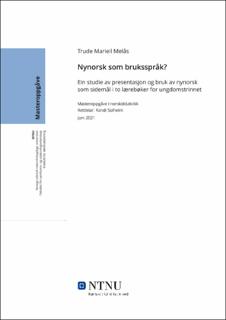| dc.contributor.advisor | Randi Solheim | |
| dc.contributor.author | Trude Mariell Melås | |
| dc.date.accessioned | 2021-09-28T17:53:16Z | |
| dc.date.available | 2021-09-28T17:53:16Z | |
| dc.date.issued | 2021 | |
| dc.identifier | no.ntnu:inspera:76519029:15447395 | |
| dc.identifier.uri | https://hdl.handle.net/11250/2785165 | |
| dc.description.abstract | Denne studien er ein analyse av korleis nynorsk er presentert i to lærebøker for norskfaget. Bakgrunnen for analysen er den prinsipielle, men ikkje reelle, jamstillinga mellom bokmål og nynorsk. Som eit bakteppe er det gjort reie for vektlegginga av kompetanse i nynorsk og bokmål i dei siste læreplanane, i tillegg til tidlegare og gjeldande språkpolitikk. Det teoretis-ke grunnlaget er sosiolingvistiske og diskursanalytiske perspektiv, der språklege ideologiar, domeneoppfatningar og markertheit er sentrale omgrep.
Studien er ein kritisk diskursanalyse av Kontekst 8-10 Basisbok og Synopsis Håndbok 8-10. Metoden som er valt er inspirert av Norman Fairclough sin modell for kritisk diskursanalyse, med bruk av dei tre nivåa for sosiale hendingar, sosiale praksisar og sosiale strukturar. Ana-lysen er delt i fire hovudkategoriar for bruk og eksponering, teksttypar, oppgåver og ekspli-sitt markering
Funna viser at lærebøkene i stor grad legg til rette for eksponering av tekstar skrivne på ny-norsk, og forlaga har såleis gjort eit forsøk på å jamstille skriftspråka i bøkene. Analysen avdekker likevel at nynorsk blir redusert til lesespråk, og at det er lagt vekt på reseptiv ny-norskkompetanse. Arbeidet med skriftleg nynorsk er konsentrert om eitt kapittel i lærebøke-ne, der særleg læreboka Synopsislegg opp tradisjonell nynorskopplæring med grammatikk og rettskrivingsoppgåver. Kontekst har ei lik tilnærming, men med meir vekt på progresjon mot produktiv nynorskkompetanse. Studien viser såleis at møtet med nynorsk i dei to basisbøkene ikkje aleine gir grunnlag for å gjere elevane til kompetente nynorskbrukarar. | |
| dc.description.abstract | This study is an analysis of how nynorsk is presented in two different course books for the norwegian subject. The analysis is rooted in the principal, but not accurate equal portrayal of bokmål and nynorsk. To provide important information, this study will explain the emphasis of competence in nynorsk and bokmål in the latest curriculum, in addition to explore former and present language politics. The theoretical foundation is based in sosiolinguistic and dis-course analytical perpectives, where language ideologies, perception of language domains and salience are sentral terms.
The study is a critcal discourse analysis of Kontekst 8-10 Basisbok og Synopsis 8-10 Hånd-bok. The chosen method is inspired by Norman Faircloughs model for critical discourse analysis, including the three levels for social events, social practices and social structures. The analysis consists of four main categories for use and exposure, text, tasks and explicit marking.
The course books greatly facilitate exposure of texts written in nynorsk, and have therefore made an effort to equalize the written languages. However, the analysis show that nynorsk is reduced to a reading language, and that the emphasis is on receptive nynorsk-competence. The training in nynorsk is concentrated in one chapter of the course books, and in the course book Synopsis one can for example see that the emphasis is on traditional grammar and spelling tasks. Kontekst has a similar approach, but with a wider focus on progression for the pupils productive competence. The study of the course books therefore show that there is still work to be done before Norwegian students can be described as competent users of nynorsk. | |
| dc.language | nno | |
| dc.publisher | NTNU | |
| dc.title | Nynorsk som bruksspråk? | |
| dc.type | Master thesis | |
